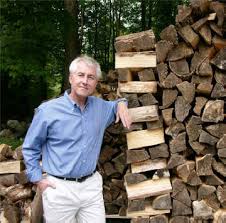This is the final post in a series introducing the 12 teams participating in the 2018 Wood Stove Design Challenge in November.
By John Ackerly, Ken Adler, and Shoshana Rybeck, Alliance for Green Heat
 |
| Niels Wittus |
Our final blog in this series is about a
partnership between a US stove importer and a German thermoelectric stove
manufacturer. Wittus-Fire by Design, lead by Niels Wittus in New York, is one of the premier retailers of higher
end European stoves in America. He is working with a team of engineers at the
German company, Thermoelect GmbH, to bring the “E-Stove” to the Design
Challenge this November 9-14, 2018, and to the US market.
Niels and his wife, Alyce, started Wittus-Fire
by Design in 1978 in the hopes of living out “the American Dream.” The Danish couple Denmark found selling European stoves in the US to be the best
way to combine their passion for their home and desire for an American life.
Since the company’s creation, Niels and Alyce have internalized Hygge, the
Danish term for “well-being” and the act of “enjoying life’s simple pleasures” in their work. From the beginning, their company was about much more than
selling wood stoves, it was about supporting healthy environments and
lifestyles. Niels truly believes that a wood stove is the “top Hygge product” that it is not only an “economical option” but also “the ultimate place where coziness,
warmth and Hygge preside.”
Meet the technical guys
 |
| From left to right: Ingo Hartmann, Frank Hoferecht, René Bindig |
Horst Erichsen, Jonas Prell, Dr. Ingo Hartmann, René Bindig and Frank Hoferecht in
Germany are responsible for all the technical elements of the E-Stove. Horst
and Jonas together with their team designed and developed the basic elements of
the E-Stove in the company Thermoelect GmbH. Ingo and René have worked together at the “German Biomass Research
Center” (DBFZ Deutsches Biomasseforschungszentrum gemeinnützige GmbH), a
government research institution, while Frank was previously working on
developing combustion units for a start-up company, ETE EmTechEngineering GmbH.
Frank, René and Ingo were brought together by a project in 2008 to design a
very low emissions stove. Niels and his German counterparts had previously
entered a stove in the Alliance’s 2013, 2014 and 2016 Design Challenges. Now, Ingo,
René, and Frank are using their experiences to help
Thermoelect GmbH create a very low emissions thermoelectric wood stove. Ingo
and Frank have a world of experience in developing combustion units with low
emissions. This will be their fourth time competing in the Wood Design Challenge
and they are enthusiastic to see all of the US teams and products, as US wood
stove technology and regulations are vastly different from those in
Europe.
The E-Stove
Thermoelect’s E-stove is a very promising
source of heat, electricity and hot water. They have achieved electricity
yields of up to 250 watts in the past using a radiator, thermoelectric
generator, and a battery to store the power. While their model
can produce up to 250 watts, producing that much runs the possibility of
producing too much heat for a single household room. So, Ingo says that their
first step is to “produce 100 watts of power as a mean value over a day (24-hour period).” To generate greater power requires
connecting the E-stove to a home’s hydronic
heating system to distribute the heat to other rooms.
 |
| Team members holding thermoelectric modules that make electricity. |
The team credits much of their combustion
efficiency as well as their subsequent emission reductions and heat and power
generation to their novel down draft combustion unit with an integrated catalytic
combustion system. Ingo says that catalytic emission control in wood combustion
units has been “a point of focus in Germany for the past 10 to 15 years.” Ingo
himself was brought to Thermoelect GmbH to research this type of emissions
control and advance their stoves’ catalytic controls. However, what started as
a project to create a stove with very low emissions became a project to create a
highly efficient stove for producing electricity and heat. The team uses
a radiator with the TEG, which is installed in the stove itself, and uses a
pump to send the water throughout a home’s hydronic heating system. The stove
runs with a large battery that is designed as backup power for the home, or
potentially to augment a solar photovoltaic system.
Thermoelect already has some units of the E-Stove
running in German homes. Ingo says that the units that are in use have been
working well, and that their main challenge is just ensuring the system does
not produce too much heat when it produces high amount of power. The team is
currently working on developing solutions to this problem in the lab. On the
users’ end, the operator can control the heat for the water output system and
has a permanent bypass at the catalytic combustion system, which is a
mandatory feature for European stoves, so the user does not have to manually switch
the bypass for the catalyst, including during cold start-up.
 |
| Niels Wittus with cordwood |
From the beginning, all Team Wittus members have been working with wood stoves to create more efficient, clean,
and affordable energy alternatives for consumers. The team believes that their
recent progress advances “greener electricity” and address the needs of “people
who do not have secure energy from the power plants.” For this reason, they work
with wood logs, as pellets tend to be twice as expensive than cordwood in
Germany, and many people have easy access to cordwood. Along with increasing
affordability, the team is also always looking for new ways to give people even
more reliable alternative energy. The E-Stove technology could be linked with
solar power to give people living in boreal climates (e.g. Canada, the Northern
US, and Scandinavia) power during times when solar power falls short.
Contact the team
Niels Wittus
Horst Erichsen
Dr. Ingo Hartmann
Frank Hoferecht



